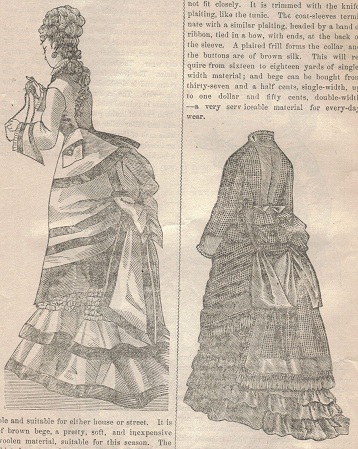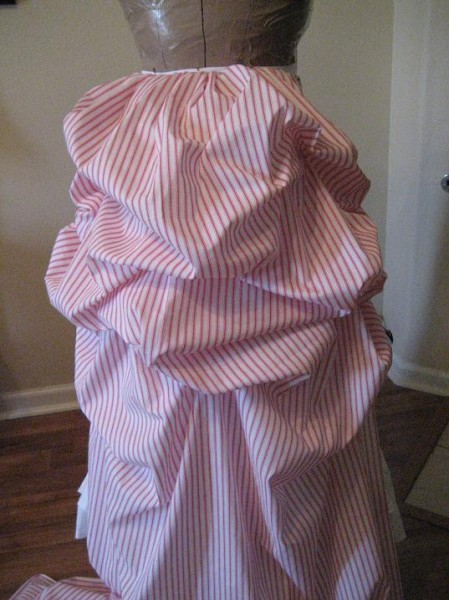
If you’ve never made a bustle dress they can look quite intimidating. The complicated fabrics swirling every which direction; the tightly-fitted bodice with a tail that floats on the skirt; the trimming that knocks you sideways with its complexity.
But under it all are actually some basic shapes. Drill down and that skirt is just 5 gored (shaped) panels around the front with the back all drawn up it its weird puffiness.
So how do you get that glorious bustle pouf? With twill tape, safety pins and room to maneuver. Here’s how…
I’ve taken the guesswork out of making a basic bustle skirt back. Here I will demo how to get even poufs on the skirt back panel. Easy-peasy.
Below, you’ll also find some helpful tips to clarify some of the things you see me working with.
1. Depending on the weight of your fashion fabric you’ll probably want to flatline it with netting. The cotton used for this demo is as-is. Two or three layers of nylon (yes, I know it’s not period correct) will give the poufs the support they need to stay in place.
2. Use three vertical rows of twill tapes. Place one at center back and the other two half way to the side seams on the left and right. Cut tapes 14″ to 30″ long depending on how many poufs you want to make and how far down you want the poufs to go along the back.
3. Start the first mark on the tapes no higher than 10″ down from the waist. Play with it on figure you’re making the skirt for.
4. The topmost marks on the side tapes are higher up than the center tape. In other words, the side tape marks are off set from the center tape marks. The center back of the skirt should pouf lower than the sides. The skirt is not as graceful to look at if the center point is higher than the sides.
5. The marks on the tapes can be anywhere from 4″ to 20″ apart. Adjust visually for the look you want.
6. Have 2 marks on the center tape and 2 to 3 on the side tapes. Remember to place the marks on the side tapes higher than the marks on the center tape.
7. You can vary the length of your skirt back to make a train. After pinning the poufs, mark & trim one half of the skirt into a round or square hem tapering up to meet the skirt side back panel.
8. This demo shows the entire skirt back bustled. You can do use this techniques to make an apron overskirt that is worn separately over a plain foundation skirt.
9. Original bustle poufs were hand tacked to very wide twill tape pieces or mounted to a fitted underlining fabric. You can simply do the same here at the marks where your skirt back is pinned to the tapes. The poufs float down over your stitching so it’s not seen. Or be very Victorian and add flowers, fancy buttons or other trims to the tacked areas. Delightful!

Use these techniques here on all your bustle skirts. Adapt them as much as you want to get the design you’re looking for. That’s the beauty of draping & using safety pins – you can adjust to your heart’s content!
For more close up photos of the draping process seen in the video visit the How to Make an 1870s Bustle Skirt page.

I’m not sure you’ll see this as this comment is so late. I love all of your tutorials and info! I was wondering how wide the twill tape has to be for the bustle (the long vertical pieces)? Should the twill tape somehow be included in the waistband of the skirt (held in place in the waistband)? Last, can I use tulle net for lining the bustle or do I need something stiffer? Thanks so much for any help you can provide!
So happy my posts are helpful!
I use 3/4″ or 1″ wide twill tape on my bustle poufs. I feel they give good support. They can be IN the waistband or tacked on the inside separately. You’ll find more here on flatlining skirts .
This was super helpful in making my over skirts, thanks for the information!
You’re welcome Myrthe! 🙂
Thank you so much for this video!! I knew I wanted a long bustle skirt for a burlesque cosplay but couldn’t find any way to create the draping shape I had in my head other than “meh I’ll just….drape…and stitch….go from there!” But now I have a clear plan! The draping is lovely! Wish me luck!
The very best of luck Suzy! 🙂
You talk about where to make the marks on the twill tape but what are the corresponding marks for the fabric?
That is where your design comes in. The position on the fabric will vary according to how big or long or flat you want your poufs. The fabric marks can start in a straight line down from the waist then adjusted to how you want them. Sorry it’s so vague. It really does depend on the look you want and how your fabric behaves with the poufs.
Does this techinque work for a front apron like drape too?
The side pleats – yes. The vertical tapes are for poufing up the fabric so would not work well for a front apron.
Hi! This video was so helpful. I am sewing bustles and bustles covers for our upcoming school play! (while directing, managing the set build, gathering props…etc…WHAT?!?!). Thank you!!!
This is basically the same technique used in 18th century polonaise dresses. It’s good to know that I can use the same things in my pretty steampunky Victorian stuff. The thought of working it out filled me with horror, only to realise I already knew what i was doing. LOL. Thanks for this hun.
Thank You SO much. this video helped me put the whole bustleing idea into a concrete idea.
Wow – I wish I had watched this video when I was trying to create my “dead bride” bustle wedding dress. This was great- and now I see how important it is to have tapes run under the bustle. Do you just tack the bustle material to the three tapes where the safety pins are pinned to the tape? I would love to see you demo how to create a draped apron to the FRONT of a dress (as in the “old west” dresses often had a pleated apron on the front.
Your video was enjoyable and educational. I can use this information for sewing as well as dressing forms in the museum. Thank you!
This video was so much help. I finished my skirt while watching and following your steps. Please post more, or step by step pics.